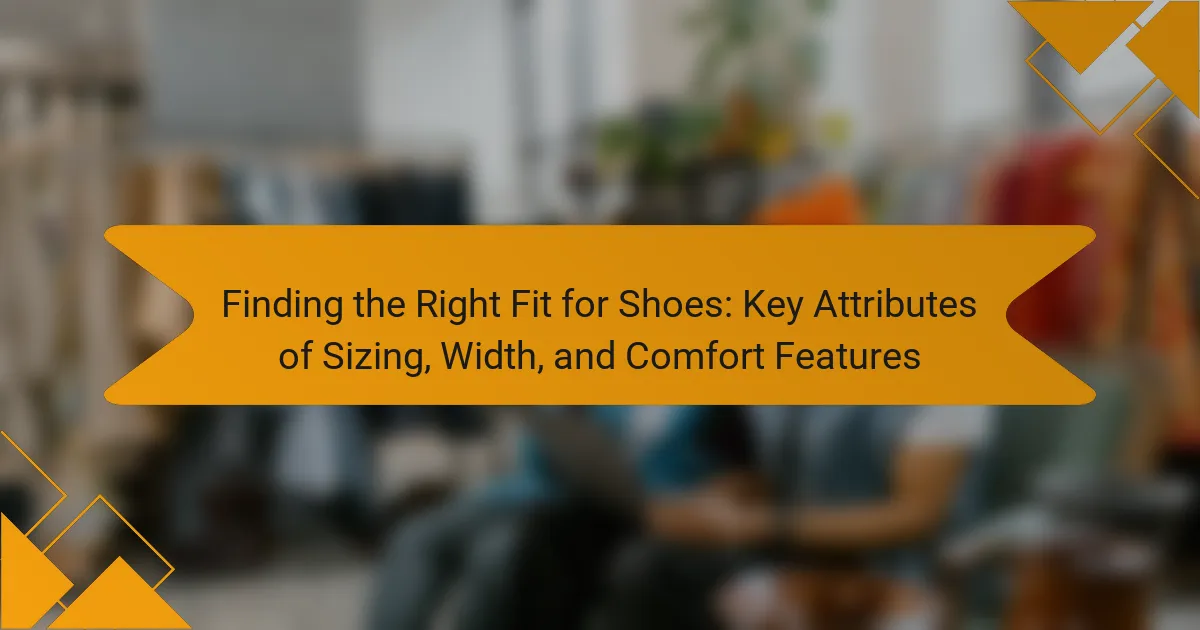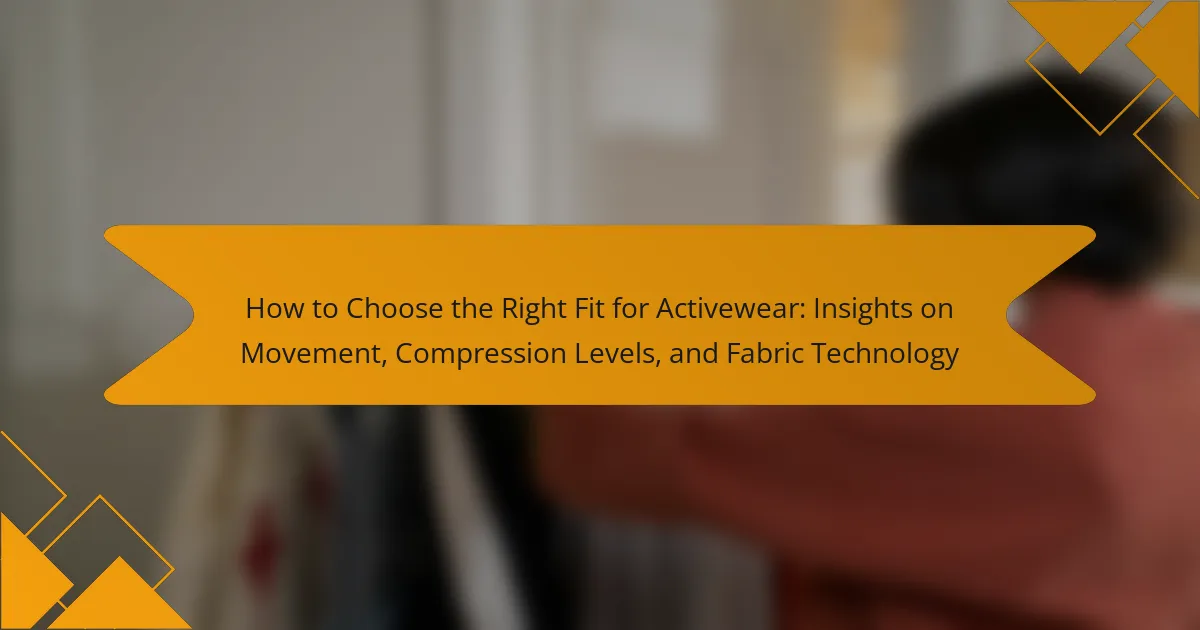Finding the right fit for shoes involves key attributes such as size, width, arch support, and cushioning. Proper sizing ensures shoes are comfortable and prevent foot pain, while width accommodates foot girth. Arch support is essential for maintaining foot health, and cushioning enhances comfort during movement. To achieve an accurate fit, it is important to measure feet correctly, try on shoes later in the day, and ensure there is adequate space for the toes. Following specific guidelines for trying on shoes can significantly improve comfort and foot health.

What are the key attributes to consider when finding the right fit for shoes?
The key attributes to consider when finding the right fit for shoes are size, width, arch support, and cushioning. Size is the most fundamental characteristic, ensuring the shoe is neither too tight nor too loose. Width accommodates the foot’s girth, preventing discomfort during wear. Arch support is crucial for maintaining foot health and alignment. Cushioning absorbs impact and enhances comfort during movement. A study from the Journal of Foot and Ankle Research highlights that improper fitting can lead to foot pain and other issues. Thus, evaluating these attributes can significantly improve shoe fit and overall foot health.
How does shoe sizing impact overall fit?
Shoe sizing directly impacts overall fit by determining how well the shoe conforms to the foot’s dimensions. Proper shoe size ensures adequate length and width, preventing discomfort during wear. A size too small can cause pinching and blisters, while a size too large may lead to instability and lack of support. Research indicates that approximately 70% of people wear the wrong shoe size, affecting their comfort and foot health. Ensuring the correct size can enhance performance in activities like running or walking. Accurate sizing also accommodates foot shape variations, such as arch height and toe box space. Thus, shoe sizing is crucial for optimal fit and overall foot well-being.
What are the standard sizing systems used globally?
The standard sizing systems used globally include the US, UK, EU, and Mondopoint systems. The US system uses whole and half sizes, typically with a scale starting from size 0. The UK system is similar but generally one size smaller than the US. The EU system uses a metric scale, measured in Paris points, which are approximately 2/3 cm each. Mondopoint is based on foot length in millimeters, providing a precise fit. These systems ensure a range of options for consumers worldwide.
How can one measure their foot size accurately?
To measure foot size accurately, one should use a ruler or a measuring tape. First, place a piece of paper on the floor against a wall. Stand on the paper with your heel against the wall. Mark the longest toe on the paper. Measure the distance from the wall to the mark in inches or centimeters. Repeat this process for the other foot, as sizes may vary. The larger measurement determines your foot size. This method aligns with recommendations from footwear experts for accurate sizing.
Why is width an important factor in shoe fitting?
Width is an important factor in shoe fitting because it directly affects comfort and support. Proper width ensures that the foot is securely held in place. Shoes that are too narrow can cause discomfort and lead to foot problems. Conversely, shoes that are too wide may not provide adequate support. A study published in the Journal of Foot and Ankle Research found that improper shoe width can increase the risk of blisters and calluses. This highlights the necessity of selecting the correct width for optimal foot health. Overall, width plays a crucial role in achieving the right fit for shoes.
What are the different width classifications for shoes?
The different width classifications for shoes include standard, narrow, wide, and extra wide. Standard width is often denoted as ‘D’ for men and ‘B’ for women. Narrow widths are labeled as ‘C’ for men and ‘A’ for women. Wide widths are indicated as ‘2E’ for men and ‘D’ for women. Extra wide widths are marked as ‘4E’ for men and ‘2E’ for women. These classifications help ensure a proper fit for various foot shapes. Accurate sizing is crucial for comfort and support during wear.
How can the wrong width affect comfort and performance?
The wrong width in shoes can significantly impact comfort and performance. A shoe that is too narrow can cause pinching and discomfort. This discomfort may lead to blisters or calluses. Conversely, a shoe that is too wide can result in instability. This instability can affect balance and overall performance during activities. Research shows that improper shoe width can lead to foot fatigue. A study published in the Journal of Foot and Ankle Research found that correct shoe fit enhances athletic performance. Therefore, selecting the appropriate width is crucial for optimal comfort and functionality.
What comfort features should be considered when selecting shoes?
Comfort features to consider when selecting shoes include cushioning, arch support, breathability, and fit. Cushioning absorbs impact and provides comfort during movement. Arch support helps maintain proper foot alignment and reduces strain. Breathability allows air circulation, keeping feet cool and dry. A proper fit prevents blisters and discomfort. Additionally, flexibility in the shoe enhances natural foot movement. These features contribute to overall foot health and comfort during wear.
What types of cushioning are available in shoes?
There are several types of cushioning available in shoes. These include EVA foam, gel cushioning, air cushioning, and memory foam. EVA foam provides lightweight and responsive cushioning. Gel cushioning offers shock absorption and comfort. Air cushioning utilizes air pockets for enhanced support. Memory foam molds to the foot for personalized comfort. Each type serves different needs and preferences for users.
How do arch support and heel height influence comfort?
Arch support and heel height significantly influence comfort in footwear. Proper arch support helps maintain the foot’s natural alignment. It reduces strain on muscles and ligaments. This support can alleviate common foot problems like plantar fasciitis. Heel height affects weight distribution and pressure on the feet. Lower heels generally provide better stability and comfort. In contrast, higher heels can lead to discomfort over time. Studies show that shoes with adequate arch support and appropriate heel height improve overall comfort levels.

How can one ensure a proper fit when trying on shoes?
To ensure a proper fit when trying on shoes, one should follow specific guidelines. First, measure both feet while standing, as foot size can vary. Next, try on shoes later in the day when feet are slightly swollen. This accounts for natural foot expansion. Ensure there is a thumb’s width of space between the longest toe and the shoe’s end. Walk around the store to check for comfort and support. Pay attention to any pinching or rubbing areas. Lastly, wear the socks you intend to use with the shoes for an accurate fit. These practices help to confirm that the shoes fit correctly and comfortably.
What steps should be taken during a fitting session?
During a fitting session, measure both feet accurately. Use a Brannock device for precise sizing. Assess the width of each foot as it can vary. Have the individual wear the socks they intend to use. Try on shoes in the afternoon when feet are slightly swollen. Walk around to check for comfort and fit. Ensure there is a thumb’s width of space at the toe box. Check for any pressure points or discomfort.
How important is it to try on shoes at the end of the day?
It is very important to try on shoes at the end of the day. Feet tend to swell throughout the day due to activity and gravity. This swelling can affect the fit of shoes. Trying on shoes later in the day helps ensure a proper fit. A proper fit reduces the risk of blisters and discomfort. According to the American Podiatric Medical Association, ill-fitting shoes can lead to foot problems. Therefore, trying on shoes at this time is crucial for comfort and foot health.
What should you look for when walking in new shoes?
When walking in new shoes, you should look for proper fit and comfort. The shoes should feel snug but not tight. There should be enough room in the toe box to wiggle your toes. The arch support must align with your foot’s natural curve. The heel should fit securely without slipping. Cushioning should provide adequate shock absorption. The material should be breathable to prevent overheating. Finally, check for flexibility in the sole to allow natural movement.
What common mistakes should be avoided when selecting shoes?
Common mistakes to avoid when selecting shoes include choosing the wrong size, ignoring width, and neglecting comfort features. Selecting shoes that are too small can cause pain and long-term foot issues. Conversely, shoes that are too large can lead to instability and blisters. Many individuals overlook the importance of width, which can affect fit and comfort. Failing to consider the shoe’s intended use can lead to inappropriate choices for specific activities. Additionally, not trying on shoes later in the day can result in selecting a size that feels tight later on. Ignoring arch support can also lead to discomfort during wear. Lastly, not considering the material can affect breathability and moisture management. Each of these mistakes can significantly impact overall comfort and foot health.
How can choosing the wrong size lead to issues later on?
Choosing the wrong shoe size can lead to discomfort and foot problems. Ill-fitting shoes can cause blisters, calluses, and corns. These issues arise from friction and pressure on the skin. Additionally, improper sizing can lead to misalignment of the foot. This misalignment may result in pain in the knees, hips, and lower back. Studies indicate that around 70% of people wear shoes that do not fit properly. Long-term wear of incorrect sizes can lead to chronic conditions like plantar fasciitis. Therefore, selecting the right size is crucial for overall foot health.
What are the signs that a shoe doesn’t fit properly?
Signs that a shoe doesn’t fit properly include discomfort, pain, and blisters. Discomfort can manifest as pinching or squeezing in the toe area. Pain may occur in the arch or heel, indicating improper support. Blisters often develop from friction caused by loose or tight shoes. Additionally, if the shoe slips off the heel while walking, it is too loose. Conversely, if toes feel cramped or curled, the shoe is too tight. Proper fit should allow for a thumb’s width of space at the toe. These signs are supported by footwear experts who recommend trying shoes on with appropriate socks and walking around to assess fit.

What are some practical tips for finding the right fit for shoes?
To find the right fit for shoes, measure your feet accurately. Use a ruler or a foot measuring device to determine both length and width. Try shoes on later in the day when your feet are slightly swollen. Walk around in the shoes to assess comfort and fit. Ensure there is a thumb’s width of space between your longest toe and the shoe’s end. Check for snugness around the heel without slipping. Choose shoes that accommodate your foot shape, whether narrow, wide, or high-arched. Finally, consider the type of socks you will wear with the shoes, as they can affect fit.
How can one make adjustments for a better fit?
To make adjustments for a better fit in shoes, one can use insoles or orthotics. These additions help customize the fit by providing extra cushioning and support. Adjusting laces can also enhance fit. Tighter lacing can secure the foot better, while loosening can relieve pressure points. Trying different sock thicknesses may also improve fit. Thicker socks can fill extra space, while thinner ones can provide more room. Shoe stretchers can be used to widen or lengthen shoes. This can alleviate discomfort caused by tight areas. Finally, visiting a professional fitter can provide personalized adjustments based on foot shape and size. These methods are proven to enhance comfort and fit, ensuring better performance and foot health.
What are the benefits of using insoles or orthotics?
Insoles and orthotics provide several benefits for foot health and comfort. They help improve alignment and support the arch of the foot. This can alleviate pain in the feet, knees, and lower back. Additionally, they can enhance shock absorption during activities. Research shows that custom orthotics can reduce symptoms of plantar fasciitis by up to 80%. Insoles can also improve overall stability and balance. Many users report increased comfort during prolonged standing or walking. Overall, they contribute to better foot function and reduce the risk of injury.
How can lacing techniques improve shoe fit and comfort?
Lacing techniques can significantly enhance shoe fit and comfort. Proper lacing distributes pressure evenly across the foot. This prevents discomfort and reduces the risk of blisters. Techniques like heel lock lacing secure the heel in place. This minimizes heel slippage and increases stability. Additionally, adjusting lacing tension can accommodate different foot shapes. For example, skipping eyelets can relieve pressure on sensitive areas. Research shows that customized lacing can improve overall foot comfort during activities. A study published in the Journal of Foot and Ankle Research found that tailored lacing techniques can lead to better performance and reduced injury risk.
What resources are available for finding the right shoe fit?
Resources for finding the right shoe fit include online size calculators and fitting guides. Many shoe retailers provide detailed size charts based on foot measurements. In-store fitting services are also available at most shoe stores. Specialized footwear apps can help measure foot dimensions accurately. Customer reviews often mention fit experiences for specific shoe models. Professional fitting services at specialty stores offer personalized advice. Online forums can provide user insights on fit and comfort. Lastly, instructional videos on fitting techniques are widely available on platforms like YouTube.
Where can one find expert advice or fitting services?
One can find expert advice or fitting services at specialized shoe stores. These stores typically employ trained staff who understand shoe sizing and fitting. Additionally, many athletic retailers offer fitting services for performance footwear. Online resources also exist, including websites that provide fitting guides and expert tips. Some brands have dedicated customer service teams to assist with fitting inquiries. Professional podiatrists can also offer advice on proper shoe fit for foot health.
What online tools can assist in determining shoe fit?
Online tools that assist in determining shoe fit include virtual fitting rooms and size calculators. Virtual fitting rooms allow customers to visualize how shoes will look and fit on their feet. Size calculators require users to input their foot measurements to recommend the correct shoe size. Brands like Nike and Adidas offer these tools on their websites. Additionally, apps like Feeture and FitFluence use 3D scanning technology to provide personalized size recommendations. Research indicates that using these tools can reduce return rates by up to 30%.
The main entity of this article is shoe fitting, which encompasses key attributes such as sizing, width, and comfort features. The article outlines essential factors for finding the right fit, including the importance of accurate shoe size, width classifications, and comfort features like cushioning and arch support. It also discusses global sizing systems, methods for measuring foot size, and practical tips for ensuring a proper fit. Additionally, the article highlights common mistakes to avoid and resources available for obtaining expert advice on shoe fitting.


